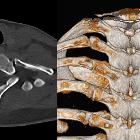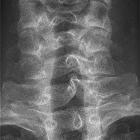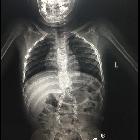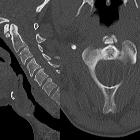Spina bifida
























Spina bifida is a type of neural tube defect/spinal dysraphism which can occur to varying degrees of severity. It is often considered the most common congenital CNS malformation.
Terminology
Spina bifida in its strictest sense means defective fusion of the vertebral posterior elements, leading to a bifid osseous configuration of the spine . However, most commonly it is used as a synonym or subset of spinal dysraphism.
Epidemiology
The estimated incidence is at 1:1000-2000 live births .
Clinical presentation
A constellation of features can occur and these depend on the severity of spina bifida and any associated CNS defects. Common symptoms include:
- back pain
- bladder or bowel incontinence
- paraplegia
- spinal or lower limb deformities including neuropathic (Charcot) arthropathy
Pathology
Spina bifida is failure of the normal development of the neural tube. The etiology is often multifactorial with both genetic and environmental factors considered to play a role. Intake of adequate amounts of folic acid plays a protective role.
Classification
There are many ways of classifying a spina bifida. One method is according to the extent of the defect and is as:
- spina bifida aperta/spina bifida operta: defect can be open or closed (commoner)
- spina bifida aperta without cystica (meningocele)
- spina bifida cystica (myelomeningocele)
- myeloschisis (spinal cord is exposed to the environment, absent meningeal/skin covering)
- rachischisis
- spina bifida occulta: mildest form
Another method is based on the position, either anterior (ventral) or posterior (dorsal). The vast majority of cases are of dorsal spina bifida.
A spina bifida can also be subtyped as:
- open: (80-90%) especially if detected antenatally
- myeloschisis
- myelomeningocele (mostly open, associated with Chiari II malformation)
- closed: if covering skin present
- meningocele (may be open)
- lipomyelomeningocele
- myelocystocele
- tethered cord
- diastematomyelia
- syringomyelia
Location
While it can occur anywhere along the spine :
- lumbosacral region (90%)
- cervical region (2-3%)
Markers
- maternal alpha fetoprotein (MSAFP): elevated in 80% of open spina bifida (and normal in most fetuses with closed spina bifida) .
Associations
Associated anomalies can occur in up to 40% of cases (especially if detected antenatally). They include:
- aneuploidic syndromic
- trisomy 18: considered the most common associated aneuploidic anomaly
- trisomy 13: relatively uncommon
- triploidy
- non-aneuploidic syndromic
- non-aneuploidic non-syndromic
- CNS anomalies
- Chiari II malformation
- fetal hydrocephalus/fetal ventriculomegaly: can be present in up to 70% of cases with an open spina bifida
- limb anomalies
- valproate embryopathy
- neurenteric cysts: particularly with ventral spina bifida
- CNS anomalies
Radiographic features
Antenatal ultrasound
Ultrasound generally has a high detection rate for spina bifida and may show dorsal ossification centers / lateral pedicles as being splayed apart (which can give a V-shaped appearance to the posterior elements).
Ancillary intracranial sonographic findings:
- lemon sign: considered to have a strong association with spina bifida
- banana sign: the appearance of the cerebellum wrapped around the medulla as part of a Chiari malformation
Notably, closed and skin covered spinal lesions typically do not have any associated cranial abnormality. A normal cranial ultrasound therefore does not exclude a neural tube defect.
Treatment and prognosis
The overall prognosis is variable depending on the type and extent. For an isolated spina bifida, the recurrence risk range for future pregnancies is thought to be around 0.3-5% . Maternal intake of folic acid in subsequent pregnancies may again reduce the risk significantly.
Complications
- lower limb dysfunction
- development of neurogenic bladder
History and etymology
The term spina bifida derives from the Latin words: bifida = split and spina = spine.
Siehe auch:
- Atlasbogenspalt
- Schmetterlingswirbel
- Arnold-Chiari-Malformation Typ 2
- Pätau-Syndrom
- Varianten des hinteren Atlasbogens
- angeborene Wirbelanomalien
- Hüftdysplasie
- lemon sign
- Meningozele
- Trisomie 18
- Klumpfuß
- fetal ventriculomegaly
- Varianten des vorderen Atlasbogens
- Myelomeningozele
- Aicardi-Goutières-Syndrom
- Roberts-Syndrom
- neuroenterische Zyste
- Fetales Valproat-Syndrom
- Triploidie
- neurogene Blase
- Neuralrohrdefekt
- Talus verticalis
- koronare Wirbelspalten
- rachischisis
- Bananenzeichen (Kleinhirn)
- Dysrhaphie
- kongenitaler Hydrozephalus
- zervikaler Bogenspalt
- increased maternal alpha feto protein (MSAFP)
- Spina bifida Sakrum
und weiter:

 Assoziationen und Differentialdiagnosen zu Spina bifida:
Assoziationen und Differentialdiagnosen zu Spina bifida:





















